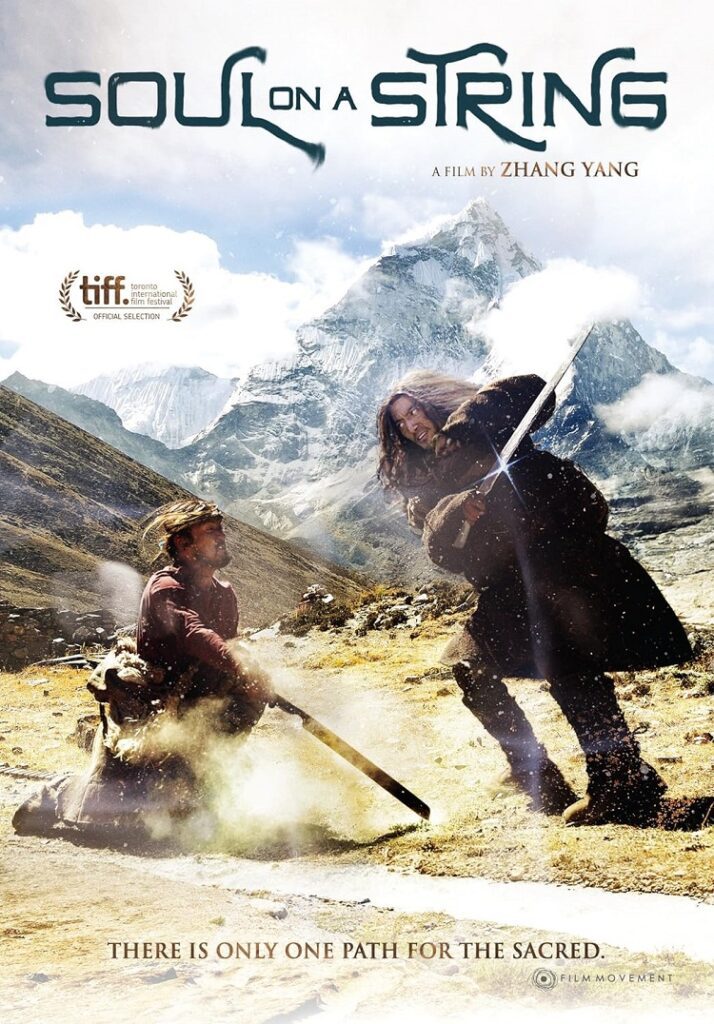
Soul on a String offers the visuals (and the length) of an epic Western, and even some of the story beats, but it certainly doesn’t share another hallmark typical of the Western: straightforward storytelling. It plays with different narrative timelines that even begin to confuse some of the film’s characters. Events seem to happen simultaneously in the past and in the present, converging in points that make any attempt to suss out a definitive timeline impossible and maybe irrelevant. All of this is in service to a pretty simple narrative: a man has to get to a mountain, while other people are looking for him.
The man who is traveling to the mountain is Tabei, who in his introductory scene kills a deer, finds a stone in its mouth and then is immediately struck by lightning. He’s brought back to life in a Buddhist monastery and told by a monk that he has to bring the sacred stone to a special place on a mountain. Exactly where is a mystery, but Tabei, who says he has many sins to account for, goes on the sacred journey.
What exactly he is doing, what it will accomplish and how it will absolve his sins is not clear. Being unclear is part of Soul on a String‘s story-telling strategy. The earliest images of the film make it looks like a period piece. Tabei’s journey through the breathtaking landscapes of Tibet are unmarred by modern technology, and his clothes look traditional, as do those of everyone he meets, including Chung, a woman who decides to follow him rather than tend goats, and later a little kid who might be some kind of psychic spirit, but is also a mute. Why Chung follows Tabei is unclear – he tries to get her off his trail by throwing things at her, but she follows anyway.
Tabei is pursued by several other people and groups, one of whom spies him through modern binoculars while standing on a hill that’s just a few yards from a paved road. This secondary protagonist, Gedan, is searching for Tabei and his sacred stone, but he’s always a couple of days behind. And, maybe several centuries late, too… except that he meets people whom we’ve seen meet with Tabei, but they don’t remember it when Gedan interviews them. Another set of followers are two brothers who seem contemporaneous with Tabei are chasing him down to avenge their father.
Only later dialogue makes it clear Tabei didn’t kill their father, but the man died in a duel with Tabei’s own father, and the blood debt has passed down along the familial lines. The younger of the brothers is obsessed with the quest, and goes so far as to kill people who just happen to share Tabei’s name, in case they’re the right one. The older brother doesn’t want to live for revenge, but vows to his mother to protect his younger brother.
The heart of the story is the relationship between Tabei and his closest followers, Chung and the little kid, whom Chung names Pu. She follows Tabei, knotting her leather belt once for each day they walk, heading… somewhere. She cooks for him, sleeps with him, and when he eventually hogties and gags Chung and Pu so he can go off on his own, she searches for him. Everyone in the movie seems to be so consumed with their puzzling tasks – Tabei on his quest, Chung on helping Tabei, the brothers on causing or preventing revenge, Gedan on following the stone for his own unarticulated reasons – that they are all they have in life.
Though all of its individual scenes are fairly straightforward, that entire picture of Soul on a String becomes murkier the more clearly we understand the individual actions of the characters. And that murkiness might be part of the point. Soul on a String is director Yang Zhang’s second film involving Tibetan Buddhism in two years, the previous being a docu-drama titled Paths of the Soul, also about a long journey. Someone better steeped in Buddhist tradition than myself could maybe unlock more from this film than I could. As it stands, there’s humor and human conflict (though the sword fight on the DVD’s cover is taking from the only fight in the movie – this is by no means a martial arts flick) and constant gorgeous landscapes. A lot of landscapes, given the film’s nearly two and a half hour running time. It’s an interesting, engaging picture, but not on I can begin to fully understand.
Soul on a String has been released on DVD by Film Movement and in streaming video. It’s unfortunate there’s no Blu-ray release, since so much of the film’s power is derived from the truly beautiful vistas on display. The DVD release does include brief liner notes from the director and an unrelated short film, “The Rifle, The Jackal, The Wolf, and the Boy” by a Lebanese Director, Oualid Mouaness.